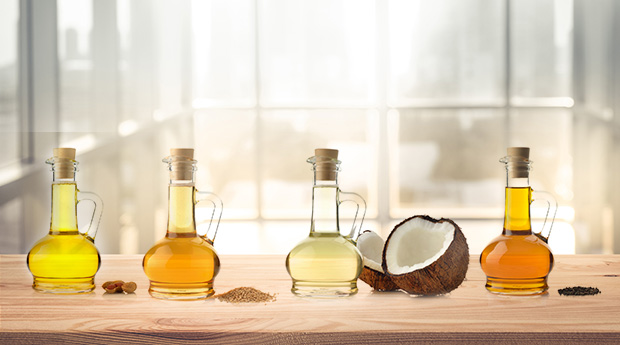

| Online: | |
| Visits: | |
| Stories: |
5 Reasons Why Carrier Oils for Essential Oils Are a Good Idea
by Dr. Eric Zielinski; The Truth About Cancer
In aromatherapy, carrier oils are essentially any oil that you use to dilute essential oils. Olive oil, evening primrose oil, almond oil, coconut oil, and grapeseed oil are just a few examples of good carrier oils for essential oils. Carrier oils amplify the healing powers of essential oils and are truly necessary in every sense of the word. At first it takes a little getting used to, but once you get your essential oil routine down, using a carrier oil becomes second nature!
Why Carrier Oils for Essential Oils Are Important
Perfect for diluting concentrated essential oils because they are less likely to irritate or sensitize the skin, carrier oils are also healing in their own right. They carry unique therapeutic and nutritive properties, which means the benefits are seemingly endless.
Now, I know what you’re thinking. It seems counterintuitive to say that diluting your essential oil makes them more powerful, but it’s true. When you use an essential oil without a carrier oil – this is called “neat” application – you are putting a highly potent oil directly on your skin.
This can be problematic for a few reasons:
- Concentrated oils can irritate the skin, which distracts from any benefit the oil intended.
- In fact, neat application can cause your body to become “sensitized,” which is a permanent allergic-type response, which may prevent you from using that oil ever again.
- Fully concentrated essential oils will evaporate off of your skin and you will not get the full benefit from using them. Remember, essential oils are “volatile organic compounds,” meaning they are easily emitted as gas when they are exposed to the air. This is why you can smell them immediately after opening the bottle.
- Essential oils cannot be properly spread throughout and massaged into the skin without a carrier oil.
- When ingesting neat essential oils, you are more likely to irritate your mouth and esophagus.
Trust me, for optimal performance, it is best to dilute all essential oils with a carrier oil with every use.
Lastly, we must not forget about sustainability. We are “consumerizing” plants and essential oils to the point of extinction, and we want to make sure our babies and grandbabies can enjoy these precious plant compounds, right?
4 Main Types of Carrier Oils for Essential Oils
If you’ve ever stepped foot inside an herbal supply store or health food store, you know there are several carrier oils to choose from. This can be overwhelming at first, but as you learn the basic benefits of each carrier oil, you will most likely settle on just a few to use regularly.
These are some of the most common carrier oils on the market. It all boils down to preference and finding the right ones for your body and skin type.
1. Kitchen Staples:
When first starting out with carrier oils, I usually recommend starting in your own kitchen. Olive oil and coconut oil are great carrier oils to start with because, chances are, you already have them on hand!
Olive Oil – This is one of the most commonly used culinary oils. However, it’s important to remember that much of the olive oil that you see on the grocery market shelves may not be pure. Many have contaminants from other similarly colored oils, such as sunflower and corn oils. [1] Make sure to read your labels and only use pure oil as a carrier oil. Try to stick with extra virgin olive oil, which is cold pressed and minimally processed. The thick scent of olive oil can be a turnoff, so it’s best used in highly aromatic blends.
Olive oil’s proven soothing and healing benefits make it the best choice for beginners. In fact, a double-blind study conducted in 2015 highlighted these effects. Diabetic patients with ulcers on their feet who were treated with olive oil for four weeks showed significant improvements over those treated with a placebo or not treated at all! [2]
Application: Good for homemade salves, creams, and oil pulling. For dry skin.
Coconut Oil – Since coconuts are actually giant seeds, oil can be pressed from them similarly to other seeds, such as sunflower. Coconut oil, which is a saturated fat, sinks into the skin easily with little oily residue and takes the oils you’ve mixed in along with it. Coconut oil provides necessary nutrients and contains a plethora of health benefits. It is moisturizing, soothing, antimicrobial (it has exceptional antifungal properties), and can actually help heal open wounds. [3]
It’s important to keep in mind that coconut oil production has an impact on its uses. For example, when coconut oil – both virgin and extra virgin – is cold pressed, it retains the coconut scent and is solid at room temperature and below. Heat processed coconut oil, on the other hand, does not keep the coconut scent or taste. Highly processed coconut oils, such as fractionated coconut oil, will not solidify. Each instance has its pros and cons. A more solid oil may be better for topical applications, while liquid oils are good for consumption. Coconut oil will harden at room temperature which may make or break some of your DIY uses, so keep that in mind as well.
Application: Good for most of your DIY projects and is a nice massage oil carrier. Tasty addition to your oil pulling ritual. Is best for dry skin as it leaves a little oily residue.
Fractionated coconut oil – Not a kitchen staple, but a cousin of your culinary favorite, fractionated coconut oil (FCO) is by far the most effective carrier to use for medicinal purposes. The long-chain fatty acids have been “fractionated” out of coconut oil making this carrier the go-to for immediate absorption. It prevents oxidation and will prolong the shelf-life of your essential oils. You will not want to waste your money making lotions and other thicker DIY projects out of FCO. This is because it absorbs too quickly.
Application: Best oil for health conditions and first aid (cuts, scrapes, etc.)
2. Nut and Seed Oils:
While nut and seed oils, such as almond oil and jojoba oil, are less common household items, they are easy to find in stores or online. They are also easy to work with and are rich sources of skin-health nutrients. Anyone looking beyond their pantry should consider these two oils.
Almond Oil – Nutrient-dense and versatile, almond oil is popular for its mild scent and taste. Almond oil is also beneficial for conditions involving dry skin, such as psoriasis and eczema because of its high levels of vitamins A and E. As an emollient, almond oil can be soothing for sore skin. [4]
Jojoba Oil – Pronounced ho-HO-ba, it is derived from seeds but classified as a liquid. This adds an interesting layer to your carrier oil of choice. While jojoba oil doesn’t solidify as quickly as coconut oil, it has a consistency that is better suited for penetration and moisturization. Another benefit of jojoba is its extended shelf life, making it easy to store for future use. Studies have shown jojoba effective as an anti-inflammatory, in wound care, and even for acne. [5,6,7]
Application: Good for most of your DIY projects and is a nice massage oil carrier. Being less “oily” than coconut, almond and jojoba are also useful for focused therapeutic uses. For dry to normal skin DIY applications.
3. Fruit Oils
Just like other carrier oils, fruit oils typically come from the seeds of their respective fruits. Kitchen staples, such as apricot, avocado, and grapeseed, are common fruit oils and are affordable and easily accessible.
Apricot Oil – Apricot oil is available pressed or cold pressed, depending on how you like it, and is rich in vitamins A and E. Apricot oil can be used topically or ingested [8] because it is one of the more gentle and nourishing oils available. It is great for uses that involve a wide swath of skin or when applied heavily on children.
Avocado Oil – It’s pretty well known that avocado, as a fruit, is an excellent source of nutrients, including good fat. I mean, guacamole, right? Who are we kidding? However, Avocado oil is an exception to the typical seed-derived oils. It is an emollient taken from the smooth flesh surrounding the pit and is great at penetrating the skin. A 2008 animal trial found avocado oil also has wound-healing capabilities. The study said of avocado oil, “Rich in nutrient waxes, proteins and minerals, as well as vitamins A, D and E…an excellent source of enrichment for dry, damaged or chapped skin.” [9]
Grape Seed Oil – Another popular culinary oil, grape seed oil is popular for its lack of residue and light texture. Also known for its wound-healing properties, [10] grape seed oil makes for cleaner topical application due to its less greasy film.
Application: Good for most of your DIY projects and is a nice massage oil carrier. Best if used on dry skin as grape seed, avocado, and apricot may leave an oily residue.
4. Essential Fatty Acid Oils
While many carrier oils (especially the ones I have already mentioned) are good sources of essential fatty acids, some oils are more well known for this reason − specifically borage and evening primrose.
Borage Oil – Produced from the seed of a flowering perennial herb, borage oil is a potent source of omega-6 essential fatty acids. Omega-3 acids are usually taken to correct an imbalance of essential fatty acids, but borage oil is different. At its root, omega-6 is an anti-inflammatory, similar to omega-3. This aids in its topical benefits, making borage oil good for dermatitis. [12]
Evening Primrose Oil – This oil gets its name from a flowering herb that only opens in the evenings. It’s a more delicate oil in that it must be cold pressed and refrigerated. Never add evening primrose oil to heat preparations. When used topically, evening primrose oil has similar health properties as borage, helping to fight inflammation and dermatitis. [13]
Application: Often found in hormone-balancing protocols, borage and evening primrose oils are thick and work very well to promote women’s health.
How to Use a Carrier Oil With Your Essential Oils
When starting out with a carrier oil, it’s best to start small until you become more comfortable or have a sanitary way of storing your blends. When storing blends, it is important to always use heat-sanitized containers, especially when storing for later use.
Here’s a simple dilution guide:
- 1% dilution (6 drops of essential oils per 1 ounce of carrier oil) – good for sensitive skin (face, genitals, underarms, babies, and toddlers)
- 2-3% dilution (12-18 drops of essential oil per 1 ounce of carrier oil) – standard adult concentration for massage oils, creams, and DIY recipes
- 5%-10% dilution (30-60 drops of essential oil per 1 ounce of carrier oil) – more for acute conditions like infections. Don’t use for more than a week at a time.
- 25% dilution (150 drops of essential oils per 1 ounce of carrier) – for one-time application like wart removal, scrapes, cuts, and other wounds.
- 50% dilution (1:1 ratio of carrier to essential oils) – not recommended unless under the supervision of a trained professional.
Stir the essential oil into the carrier, then apply as indicated. And that’s that! You’ve successfully diluted your essential oil and enjoyed the added benefit of a nourishing carrier oil.
Every Day is Earth Day
Source: http://feedproxy.google.com/~r/riseearth/KZKa/~3/bnsUO8Hhbf4/5-reasons-why-carrier-oils-for.html




